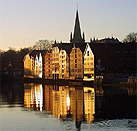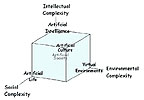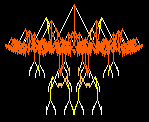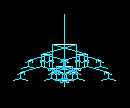| |
Tuesday |
Thursday |
|
| |

Genetic & Evolutionary Computation Conference
Montreal / July 8-12, 2009
CFP due January 28
|
IEEE Alife 2009
Nashville / March 30 - April 2009
CFP due November 12
ECAL 2009: Darwin Meets von Neumann
European Conference on Artificial Life
Budapest / September 9-12, 2009
Cached Version
|

IEEE Congress on Evolutionary Programming
Trondheim, Norway / May 18-21, 2009
CFP due November 14
|

World Summit on Genetic and Evolutionary Computation
Shanghai, China / June 12-14, 2009
CFP due December 20
|
|
| |

Symposium on Cryptologic History
Laurel, Maryland / October 15-16, 2009
|
|
|
Starting
from scratch, SaveProjectAs is clicked ONLY ONCE at the beginning of an application BEFORE you push
the GREEN arrow. Click SaveAll repeatedly.
To
resume working on a previously saved project Double-Click on Project1.bdsproj. This will open Borland along with your project.
DO
NOT type in or delete event-handlers by yourself.
Let Borland do it.
ALWAYS
use Borland with your application on the WorkSpace. NEVER use it directly
with your USB or CD-ROM. Transfer folders between the WorkSpace and your
USB or CD-ROM only when Borland is CLOSED. |
|
| |
Color Code:
Notes on previous days. |
Color Code:
Reasonably certain agenda. |
Color Code:
Just notes from last year. |
|
Week
0 |
|
January 8
INTRODUCTION to the course and to Borland and C++ for Windows...
Video: Karl Sims "Evolved Virtual Creatures."
Programming
Exercise
Writing a Windows application from scratch, just some frivolous fun... |
|
|
Week
1 |
January 13
INTRODUCTIONS:
Participant introductions.
The course itself and Borland and C++ for Windows...
Introduction to the origins of computation:
Once over lightly on the cryptographic foundations of computation: The Hebern machine, the Enigma, the Swiss NEMA (Neu Machine) and the Russian Fialka.
PowerPoint Introduction to Artificial Culture.
Networks of secrecy, trust and deception occur in all human activity in all cultures. In the military, psychological operations and intelligence communities these practices are raised to a high art and we will use examples from these domains to shed light on everyday human behavior.
Physically Intermediated Cultural Cognition
Participant Reports on Current Issues.
I invite each of you to investigate issues related to the course that appear in the news or are otherwise of interest. As some examples, I have begun some webpages on yellow dot codes, the Eurion constellation, invisible UV markings and algorithms for detecting currency in images. RFID would be another interesting theme to develop.
Programming
Challenge 0: Halfway There
Writing a Windows application from scratch, programming on the fly...
Blocking out the code in terms of what jobs (functions) are needed to get the job done.
Your constant friends: Programming Errors.
Pause/Pause and cursoring over variables to reveal their current values.
What you need...
Our PARTICIPANTS
page.
Our INDEX
pages...
Our SIMULATIONS
pages...
What is AGENCY?
agency as causation...
agency as functionality...
agency as sense, think & act ("STA")
complexity as multiagency
multiagent & agent-based-modeling |
January 15
DVD Short: "Spy School: Inside the CIA Training Program" a special feature from the movie THE RECRUIT.
Networks of secrecy, trust and deception occur in all human activity in all cultures. In the military, psychological operations and intelligence communities these practices are raised to a high art and we will use examples from these domains to shed light on everyday human behavior.
Remember:
Don't let BORLAND see anything other than your desktop (or if you must, your private server space).
Never invoke SaveProjectAs more than once. Never, never, never change its target!
For safety, unplug your USB stick while using Borland.
Never write or delete an event handler yourself. Let Borland do it for you.
Debugging:
Programming Errors are your friends. Don't be afraid of them...
Pausing to probe the values of variables can be an incredibly useful aid.
Don't forget to constantly be thinking of how the code relates to the behavior of the software.
Study the way the software behaves in order to understand how the code works or doesn't work to your expectations.
Review of the Handout and Review
of the Fundamentals:
Dos & Don'ts
Borland IDE (Integrated Development Environment)
Windows API (Application Programmers Interface)
Windows & C++ Programming Fundamentals.
Backing up your work:
Remember to back up your project file work on your USB stick and or your private server space.
Remember to click SaveAll after every few successful runs.
How to save versions of your work in different stages:
- Close down Borland.
- Copy and Paste a duplicate of your entire project folder.
- Rename the duplicate folder as version 2 (3, 4 or whatever).
- Open that new folder and double-click on Project1.cbproj.
Programming
Challenge 0: Halfway There (due next Thursday morning)
Continuation: Writing a Windows application from scratch, programming on the fly...
To re-open your work in Borland, simply double-click on Project1.cbproj.
Some challenges revisited: Keeping the user from entering more than one camp location.
Comment your code profusely...
Some Tweaks:
Adding Color - the ColorRamp function
Pasting-in (stealing) code...
Some enhancements on our simulations pages.
For Tuesday:
Study your handouts and see what you can do the enhance your application. |
|
| |
The
Standing Assignment for All Programming Challenges
DETAILS
Explore
- Thoroughly familiarize yourself with the application and its behavior.
Enhance - Improve the visualization
and the interface and modify the multiagent algorithmic code.
Experiment - Document in color screen
shots and text your new "what-if" scenarios.
Enjoy - Be creative! Be bold! Some
things will work; some won't.
|
|
Week
2 |
January 20
Adding an Icon - IconEdit32.
Some new visual components:
TTrackBar to select the number of iterations.
TEdit to show the iterations after a run.
TRadioGroup to select the type of visualization.
FormPaint to restore the screen when it is uncovered.
TPanel to create a more logical GUI (graphical user interface).
TLabel to enhance the GUI.
Some new enhancements:
Adding a new function to count the maximum number of hits on a pixel.
|

We quit at 11:30 for the President Obama's Inauguration. We'll try tuning it in on CNN but I suspect there may be an Internet bottleneck, so keep an eye out for televisions. |
January 22
Some new enhancements:
Changing the Properties/Settings/Screen Resolution from 1024x768 to 1680x1050.
A faux shadows function.
Adding sound: Beep(), MIDI and PlaySound()...
Slowing things down for dramatic effect with Sleep().
Going where we haven't gone before: 3D?
Some tweaks to the algorithm (algorithm "bending"):
Changing the divisor.
Changing (corner + point)/2 to (corner - point)/2.
In-Class Individual
Practice and Review...
Explore - get to know it!
Experiment - describe & explain it's behavior!
Enhance - add new functionality!
Enjoy - play with it! |
|
| |
|
|
Week
3 |
January 27
Programming
Challenge 0: Halfway There
Due Today.
Participant demonstrations...
Video: Jeffrey Ventrella "Disney Meets Darwin."
Evolutionary Computation and Multiple Agency
The "Evolutionary Concert Tour," revisiting the travelling salesman problem.
Evolution after Charles Darwin and Alfred Russel Wallace,
how the mechanisms are encoded in the software:
- Recombination: Reverse, Shuffle, Rotate with preset and random parameters.
- Reproduction: Asexual, sexual, "orgiastic" (multisexual).
The fitness landscape.
Modifying the fitness function:
- Shortest distance
- Longest distance
- Penalty/Bonus for crossing boundaries
- Optimizing paths to visit alternating versus same households
- Moving everything into 3D, the "Travelling Ferengi Problem."
What other fitness criteria could we add without too much difficulty?
Please hand in your ideas and discuss them on Thursday?
|
January 29
Programming
Challenge 0: Halfway There
A few more participant demonstrations...
Video: Karl Sims "Galapagos."
Evolutionary Computation and Multiple Agency
The "Evolutionary Concert Tour," continued...
Modifying the fitness function:
What other fitness criteria could we add without too much difficulty?
The fitness landscape, a visual metaphor derived from a two-variable problem,
where the fitness of combinations of the two variables is plotted as the elevation:
- Smoothness or ruggedness of the landscape.
- Local optima versus global optima.
- Evolution procedes by hill-climbing.
- How reproduction and recombination ("mutation") climb hills.
The combinations pathways in the ECT is vastly larger than the 2d example above.
How do we visualize the fitness landscape for the ECT?
By plotting the optima we discover, but we don't know what the slopes look like...
More "Nuts & Bolts" issues:
- Bits, bytes and hexadecimal codes.
- ASCII code: the Tektronix Chart and the full ASCII chart.
- Notepad.
- SynEdit.
- Writing to "Save" and reading from "Open" a file (deferred until GOL)
- Decrypting ASCII "text" data. (Handout)
For next Tuesday, please try to solve these coded messages:
to be posted this afternoon
Note: I will be in Los Angeles and incommunicado until Tuesday.... |
|
|
Week
4 |
February 3
Programming
Challenge 1: Conway's Game of Life:
An introduction to multi-agent massively-parallel programming with cellular automata...
If some features of your application don't work properly, please check them against the
GOL source code that we developed today.
|
February 5
Using the Windows Accessories / Calculator / Scientific to compute binary and hexadecimal representations.
Mirek's Cellebration
A generalized 2d 2state
application:
Try B1L3 with a single dot.
Try B1L34 with three contiguous dots.
Some variations on Conway's GOL:
Using CAs as "trap-door" functions.
ColorRamping deaths or births.
When does the simulation "end?" Plotting the population through time.
Programming
Challenge 1: Conway's Game of Life:
continued...
If some features of your application don't work properly, please check them against the
GOL source code that we developed today.
Enhance the application. You might include several buttons which introduce new (seed)
patterns on the screen.
Experiment and Explore the GOL and prepare an ethological study of several aspects of that world in detail: e.g. relative proportions of various species, interaction of species with single cells, different initial conditions, designing creatures with special behaviors, etc.
Discursive
Challenge 0: Ed Fredkin's "Digital Philosophy:"
Please read:
"A Finely Mottled Universe" (please check the "BlackBoard" for it's appearance).
"A New Cosmogony" on the web.
Discuss Fredkin's notion of "other" in relation to cellular automata, reality and other "relevant" philosophies or epistemologies.
Conway's
Life Glossary (a creature directory)
Various ways to seed Conway's world with specific creatures...
Creating a palette of TImage transparent bitmaps (.bmp) which look like buttons...
(The bottom-left pixel will be taken as the transparent color and the RGB values must be dead-on exactly the same.)
Using a TComboBox or TRadioGroup to select creatures...
Note: I will be in Tucson and incommunicado until Tuesday.... |
|
|
Week
5 |
February 10
Programming
Challenge 1: Conway's Game of Life:
continued...
Executable won't run on any other PCs?
Be sure that Project/Options/Linker/Linking "Dynamic RTL" is UNchecked!
Be sure that Project/Options/Packages "Build with runtime packages" is UNchecked!
Then press the green Run arrow...
Application start-up:
In the form constructor event-handler: reset(RANDOM).
In the PaintBox OnPaint event-handler: showThisWorld().
The TMainMenu component.
The
difference between random() and Randomize().
Cleaning up the graphics with DoubleBuffered = true.
Using the MouseDown event to draw on the PaintBox.
Using a transparent bitmap TImage on a TPanel as a palette of "creatures" to be chosen for a MouseDown event.
Changing the Cursor property of a visual component.
FileSave and FileOpen dialogs...
|
February 12
Programming
Challenge 1: Conway's Game of Life: DUE TODAY:
Participant demonstrations...
Discursive Challenge 0: Ed Fredkin's "Digital Philosophy": DUE TODAY:
Discussion...
Programming
Challenge 2: Evolutionary Concert Tour (ECT) Revisited:
In preparation for EVOLUTION WEEKEND:
Please see what you can do to tweak and enhance the ECT application...
We download the zipped project files and open them in Borland.
What you might try:
Implement some of the other selection criteria that we discussed two weeks ago.
Implement some other reproduction criteria (sexual, orgiastic, hybrid, etc.).*
Implement some other recombination or "mutation" mechanisms.*
How do these changes compare with the original evolutionary parameters in terms of speed of arriving at an optimum or in terms of the shape of the fitness landscape?
Why
do you think the changes produced different results?
*It would seem best to pick operations that only produce valid offspring...
How would you go about evolving a solution to Sudoku?
(Solving the "pattern" of numbers rather than the precise numbers themselves.)
How would you go about evolving a solution to a monoalphabetic substitution cipher?
Please prepare to turn in your modified project files.
Discuss in writing the code you wrote or modified and the results you observed.
Discuss in writing answers to the questions above. |
 12 February 1809
12 February 1809
to
19 April 1882 |
|
Week
6 |
February 17
Video: National Security Agency.
Johnny Depp narrates...
I would like you to think about the role of the intelligence communities, specifically their practices of cryptography and cryptanalysis, as the catalysts for the development of the computer as we know it. These are state-level actors managing "networks of trust, secrecy & deception" through both human agency and technology, but beneath the state-level, all the way down to the level of the individual, these same processes take place. We, as individuals, groups and corporations, manage our own "networks of trust, secrecy & deception," in equally complex ways, though perhaps less vigorously and with fewer resources. Please be thinking about how we interact with others, and how we sculpt our own personas and our material and physical environments to further our own ends. Think about how cognition does not exist solely in our heads, but also in our physical surroundings. Think about the "media" through which cognition operates and how information passes from one medium to another and is, in this process, changed. Think about how "physically intermediated cultural cognition" could be written into the computer simulations we are working with...
Programming
Challenge 2: Evolutionary Concert Tour (ECT) Revisited:
In class work on the challenge...
|
February 19
Programming
Challenge 2: Evolutionary Concert Tour (ECT): DUE TODAY:
Participant demonstrations and discussions...
PROGRAMMING CHALLENGE 3: Schelling's Segregation Model and
Diffusion Limited Aggregation, an introduction to the user's view...
Let's see what we can do to put more "smarts" into the agents' heads...
|
|
|
Week
7 |
February 24
PROGRAMMING CHALLENGE 3: Schelling's Segregation Model and
Diffusion Limited Aggregation, an introduction to the coder's view...
Let's see what we can do to put more "smarts" into the agents' heads and more complexity into the environment...
Maps - Thinking About Intermediation.
How are maps designed (how they convey visual or tactile information to the user and how the physical characteristics of the medium in which that information mediate that process) in difficult social and physical environments and situations (think about emergency and military situations where "getting it wrong" can cost lives)?
Situation maps.
War rooms.
Kuwait sand table.
Google Earth:
38°15'57.38"N
105°57'22.43"E
Google Earth sandbox.
The Sluis digital elevation model: explanation, application.
The color bitmap .bmp.
Some added tweaks:
A) The neighborhood has been expanded to 48 cells which also means that a 24 cell ring neighborhood is available.
B) The application can now accommodate assimilation. Note that a modification must be made to keep the program from halting.
C) Demo of some new patterns which emerge with ring neighborhood rules.
D) What about mixing segregation and assimilation rules? |
February 26
Steganography - information hiding vs. Cryptography - information encipherment
The one-time pad... A Russian OTP.
Generating random ont-time-data: vacuum tube noise, radiation.
Radiation as a function of altitude in aircraft.
Deniable encryption...
Hiding information in images, sound files, text, etc...
Discursive Challenge 1: Contemporary Asymmetric Cryptology & Steganography: Keeping in mind the video "National Security Agency," and the notion of "physically intermediated cultural cognition," what are the asymmetric methods that are thought to be in use today by "terrorists" (insurgents) and states? What are the logistic, technological, economic and cultural contexts of these communications? (Journals, conference proceedings and the Web (perhaps Wikipedia) may be among your best sources although the library may have books on the subject.)
PROGRAMMING CHALLENGE 3: Schelling's Segregation Model and
Diffusion Limited Aggregation, continued...
How is space represented? Cellularly, as location and as bitmap channels...
How is time represented? Agent/Spaces are polled randomly...
How are agents represented? Minimally, as the spaces themselves...
Agent/Space types: Cyan, Magenta, Yellow, Silver...
Agent/Space types: White (barriers) and Black (empty space)...
Writing rules... |
|
| |
Evolution
On the Web
|
|
Week
8 |
March 3
PROGRAMMING CHALLENGE 3: Schelling's Segregation Model and
Diffusion Limited Aggregation, enhancing the application, continued... |
March 5
PROGRAMMING CHALLENGE 3: Schelling's Segregation Model and
Diffusion Limited Aggregation, DUE TODAY.
Participant Demonstrations...
Discursive Challenge 1: Contemporary Asymmetric Cryptology & Steganography. DUE TODAY.
Discussion...
Video: Artificial Life (VPRO Amsterdam) |
|
| |
March 10
SPRING RECESS |
March 12
SPRING RECESS |
|
| |
NEXT: GPS, FLOCKING, REALWORLD INTERFACING, "REALITY MINING"... |
|
|
Week
9 |
March 17
!!! Any late programming & discursive challenges and must be in by next Tuesday !!!
!!! Be Thinking of a Course Project !!! (Start early.)
Segregation/Assimilation Revisited:
RGB gradient-climbing on a color bitmap image emulates "painting with smart particles."
Discursive Challenge 2: Contemporary ALife, ACulture, EvoComp Research. DUE TODAY
Search the Web to find out what is currently going on in the fields of Artificial Life, Artificial Culture and/or Evolutionary Computation. Search for current research by the artists and scientists interviewed in Thursday's video, by presenters at the various conferences in the links above, by David Fogel, John Koza, or anyone in the field. What is his/her research project? What is the question under study and the philosophy invoked to discover answers? What algorithms are used? How does the researcher's work differ from traditional scientific practice? Present (in writing) an overview and critique (with citations). Be prepared to present your investigation in class...
Discursive Challenge 3: Philosophy of ALife, ACulture, EvoComp Research. DUE TODAY
Discuss (critique, compare, contrast, comment), in writing, citing possible applications in your own field, the philosophies, epistemologies and ideas presented in the four articles handed out in class:
TIME Magazine 1950, "Can Man Build a Superman?" a.k.a. "The Thinking Machine."
Marvin Minsky, Public Lecture, Nara, Japan (1996).
Gessler, Nicholas, "Review: On the Order of Chaos" (2007) and "Intermediation & Emergence" (2008).
PROGRAMMING CHALLENGE 4: Flocking, Herding, Schooling, Crowd behavior...
An introduction to the User's side...
Familiarize yourself with how it works.
Experiment...
|
March 19
Eventually, we will be displaying some of your work publically in the ISIS space: See Warehouse. Consequetly, pay attention to the aesthetics of your application as well as its complex functionality...
Changing the "LOOK" of your applilcation: Graphics
Getting away from Windows and Buttons...
Using drop-down Menus...
PROGRAMMING CHALLENGE 4: Flocking, Herding, Schooling, Crowd behavior...
An introduction to the Programmer's side...
Practice enhancing the simulation
... |
|
| Week
10 |
March 24
PROGRAMMING CHALLENGE 4: Flocking, Herding, Schooling, Crowd behavior...
Adding new behavioral rules.
Changing the imagery.
In-class work on simulation... |
March 26
Video: Robofest Osaka 2001
PROGRAMMING CHALLENGE 4: Flocking, Herding, Schooling, Crowd behavior...
Version 18: Some enhancements to the "Banking" behaviors we began on Tuesday.
Remember that new "thing" agents require image coordination.
Collisions? Try: if(myDirection ?= directionToNN && distNN < radius) myDirection++
In-class work on simulation. |
|
| Week
11 |
March 31
PROGRAMMING CHALLENGE 4: Flocking, Herding, Schooling, Crowd behavior...
DUE TODAY:
Participant demonstrations...
PROGRAMMING CHALLENGE 5: Physical and Real-World Computing.
INTRODUCTION - Smartening up your computer. Connecting sensors and actuators...
EZLINK on eBay
The EZLINK card.
Physical Computing & Real World Interfacing: |
RFID
Radio Frequency Identification |
Phidgets |
|
|
|
GPS
Global Positioning Systems |
Garmin GPS-12 |
|
|
|
| Magnetic Stripe Readers/Writers |
|
|
|
|
| AD/DA Converters |
National Instruments |
EZIO |
Arduino |
Phidgets |
Sensors &
Actuators |
Bally Virtual Reels |
|
|
|
| True Randomness |
Background Radiation |
|
|
|
| Universal Aerial Video Platform |
UAVP |
|
|
|
Robotics:
MIT Leg Lab
Boston Dynamics: Little Dog, RoboHex, RiSE, Big Dog
|
April 2
FLOCKING SIMULATION:
Two bugs have been corrected:
The "Add" button now adds agents with sexual consistency.
The "Boundary" and "Behavioral" sonifications will not run simultaneously and the checked items in the "Sonification" menu operate correctly.
PROGRAMMING CHALLENGE 5: Physical and Real-World Computing.
Smartening up your computer. Connecting sensors and actuators...
Working with the EZIO board:
Applications which talk to the EZIO - "Realworld Interfacing."
The EZIO board itself and how to talk to it.
A reed relay board to boost the EZIO's power:
xxxxxpartially wired
xxxxxwired and ready to go
xxxxxconnected to six stepper motors
. |
|
| Week
12 |
April 7
Flocking revisited: moving the two banks (moveTargets())...
PROGRAMMING CHALLENGE 5: Physical and Real-World Computing.
Work in class on EZIO challenge.
A Telephone application.
A Stepper-Motor scanner.
Modifications to the Bally Reel driver. |
April 9
ATSAC The Los Angeles Automated Traffic Surveillance & Control Center: Realworld and evolutioanry computing.
A laser gun
PROGRAMMING CHALLENGE 5: Physical and Real-World Computing.
Work in class on EZIO challenge.
A Telephone application.
A Stepper-Motor scanner.
Modifications to the Bally Reel driver.
|
|
| |
If Classroom #6 is locked, go to the Library Circulation Desk (one floor up).
Tell them you are from my class. They should then let you in.
Please be sure to lock up (the cabinet and the door) when you leave.
|
|
| Week
13 |
April 14
A re-organized RealWorld applications page and some new RealWorld applications:
For today's roll, please swipe your Duke (or any other card) near the rack at the back...
The Omnilux Tower...
The Laser Galvanometer...
PROGRAMMING CHALLENGE 5: Physical and Real-World Computing.
DUE TODAY:
Participant Demonstrations
COURSE PROJECT
In-class work... |
April 16
The German ENIGMA machine:
The stimulus for the development of the computer.
Wikipedia entries on the Swiss "NEMA" and Russian "FIALKA."
In-class decryption exercise with the "NEMA" rotor machine.
"The Liberty Incident."
COURSE PROJECT
In-class work... |
|
| |
Please make sure to have everything turned in by the end of class, April 21st. I will be out-of-state for the Summer. |
|
| |
I will be available to help on programming challenges on Monday, from 10 until Noon.
I will be in Classroom 6. If it is not available, I'll be looking for another PC on that floor.
Please ask where those may be, there are some scattered near the printers, and some clustered at a lower level near the CIT offices. |
|
| Week
14 |
April 21
Coffee, cookies & refreshments:
Course evaluations: Supplementary questions:
1) Would you prefer to have coding examples printed out for you rather than working with them on the Web?
2) Would you prefer to have readings printed out for you rather than reading them on the Web?
3) Would you prefer to have more or fewer readings on the philosophical, cultural, scientific and cultural issues?
4) Would it be useful to have periodic objective quizes?
Course Project Presentations... |
!!! Have a Great Summer !!! |
|
|
No
Final |
No Final |
No Final |
|











